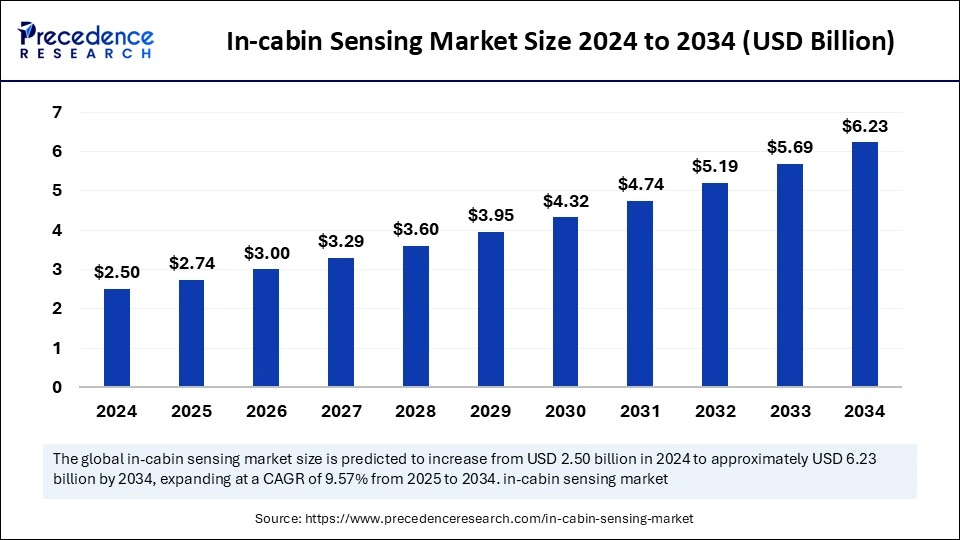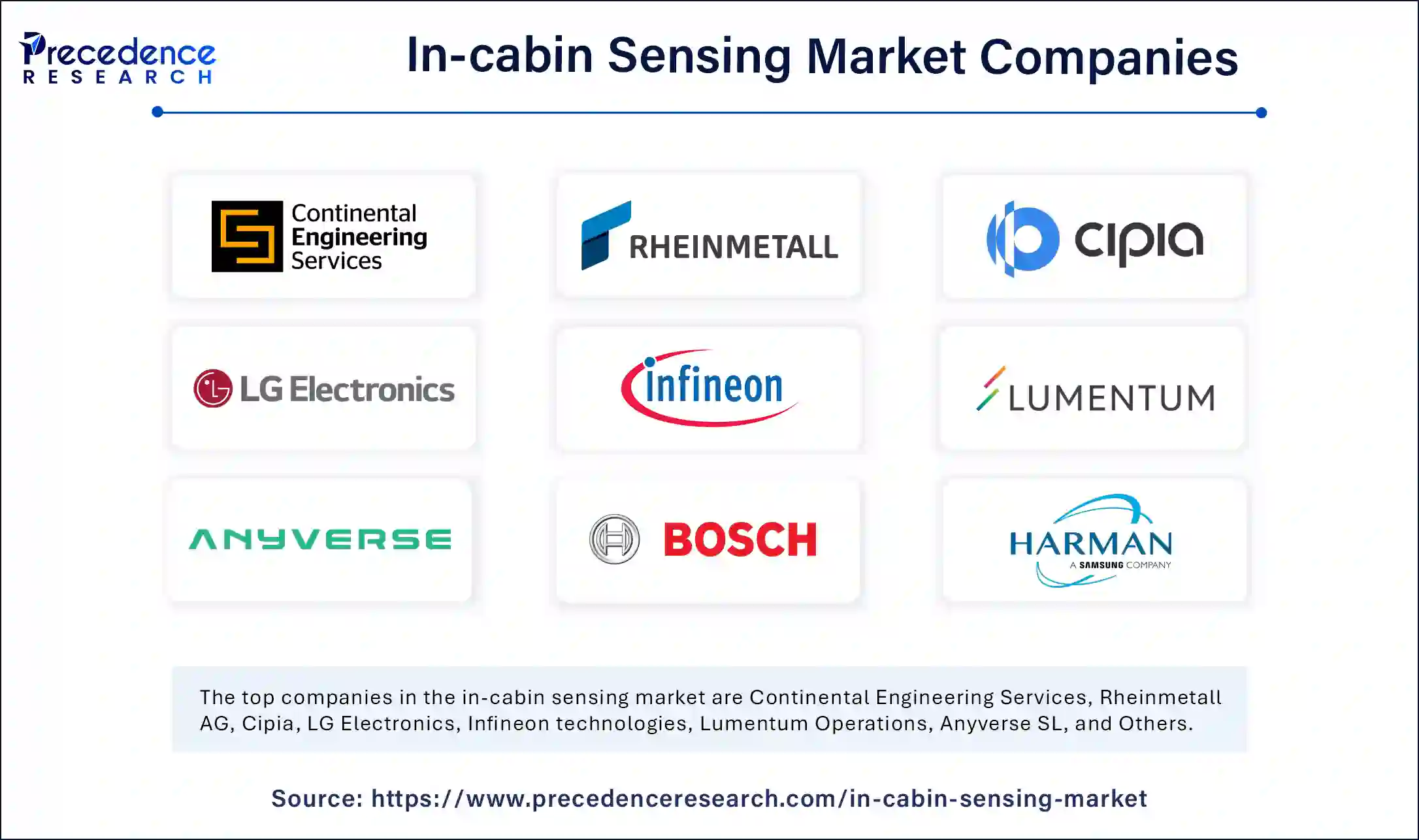February 2025
The global in-cabin sensing market size is calculated at USD 2.74 billion in 2025 and is forecasted to reach around USD 6.23 billion by 2034, accelerating at a CAGR of 9.57% from 2025 to 2034. The market sizing and forecasts are revenue-based (USD Million/Billion), with 2024 as the base year.
The global in-cabin sensing market size accounted for USD 2.50 billion in 2024 and is predicted to increase from USD 2.74 billion in 2025 to approximately USD 6.23 billion by 2034, expanding at a CAGR of 9.57% from 2025 to 2034. Factors such as rising investment in innovative technologies by the automotive industry and rising focus on advancing passenger and vehicle safety are expected to drive the growth of the in-cabin sensing market throughout the forecast period.

In the era of a rapidly evolving digital landscape, artificial intelligence (AI) technology emerges as a transformative force. It holds great potential to reshape the automotive industry, delivering safer and more personalized driving experiences. Integrating AI in in-cabin sensing solutions delivers advanced safety and convenience solutions for the automotive industry. AI-enabled radar sensors have led automakers to deliver smarter, safer, and more connected driving experiences. AI analyzes vast amounts of data from the driver monitoring system (DMS) to improve the accuracy and reliability of in-cabin sensing systems. AI solutions assist in detecting and responding to vehicle occupants' evolving needs while optimizing cabin conditions. Moreover, AI can analyze driver and passenger preferences, enabling personalized in-cabin settings.
In-cabin sensing refers to the advanced monitoring systems in the vehicle interior. In-cabin sensing system significantly enhances vehicle safety through advanced radar sensing technology. These systems use multiple technologies to effectively monitor and comprehend the vehicle interior, enhancing safety and comfort through additional features such as intrusion monitoring, seatbelt reminders, occupant detection, child monitoring, and driver attentiveness analysis. The in-cabin sensing market is witnessing rapid growth due to the increasing focus on enhancing vehicle safety and the rising production of autonomous vehicles.
| Report Coverage | Details |
| Market Size by 2034 | USD 6.23 Billion |
| Market Size in 2025 | USD 2.74 Billion |
| Market Size in 2024 | USD 2.50 Billion |
| Market Growth Rate from 2025 to 2034 | CAGR of 9.57% |
| Dominated Region | North America |
| Fastest Growing Market | Asia Pacific |
| Base Year | 2024 |
| Forecast Period | 2025 to 2034 |
| Segments Covered | Sensor Type, Monitoring System, End-user, and Regions |
| Regions Covered | North America, Europe, Asia-Pacific, Latin America and Middle East & Africa |
Rising Popularity of Autonomous Vehicles
The increasing production and adoption of autonomous vehicles is a key factor driving the growth of the in-cabin sensing market. Autonomous vehicles rely heavily on in-cabin sensing to enhance driver experience. As autonomous vehicles focus on ensuring the safety of drivers and passengers, there is an increasing need for in-cabin sensing solutions. The surge of autonomous and shared transportation has considerably increased the demand for efficient in-vehicle cabin sensing without compromising passengers’ privacy. Cabin Sensing solutions are critical in monitoring the attentiveness of the passenger and enhancing the safety of autonomous driving. In-cabin sensing uses microphones and cameras to track and analyze driver and passenger activities within a self-driving vehicle. It can analyze driver and passenger behavior as well as capture conversations to gain critical insights into their preferences.
Stringent Regulations
Stringent regulations are projected to hinder the growth of the in-cabin sensing market. As in-cabin technology continues to evolve, regulations imposed by several governments are becoming more stringent, which often leads to complex assessment programs and consumer tests for manufacturers. In addition, the slow adoption of autonomous and connected vehicles in middle- and lower-income countries adversely affects the growth of the market.
Technological Innovations
The emergence of advanced technologies is pushing the boundaries of in-cabin sensing and delivering advanced safety solutions for the automotive industry, offering lucrative growth opportunities in the in-cabin sensing market. In-cabin sensing solutions require accurate real-time vision and radar data analysis. In-cabin sensing systems use a wide range of technologies to effectively monitor and comprehend the vehicle interior and enhance comfort and safety through seat belt reminders, child monitoring, occupant detection, intrusion monitoring, driver attentiveness analysis, and others. These systems can be integrated into connected vehicle technologies to provide real-time information. Technological advancements have significantly increased the need for sensors in advanced driver assistance systems, vehicle connectivity, vehicle automation, and advanced mobility services to boost the safety of vehicles.
The capacitive steering sensors segment dominated the in-cabin sensing market with a major share in 2024. Capacitive steering sensors assist in enhancing driver safety by precisely detecting hand movement on the steering wheel. With the surge in autonomous driving technology, hands-on-wheel detection has gained immense traction. The capacitive steering sensor offers flexibility, reliability, and long-lasting capacitive sensing for human interaction detection and is widely used in numerous applications in the automotive sector.
The torque steering sensors segment is expected to witness significant growth during the forecast period. Torque or angle sensors are reliable components that detect torque in the steering wheel or steering wheel position for precise regulation. These sensors contribute to enhanced vehicle safety.
The driver monitoring systems segment held the largest share of the market in 2024. Driver monitoring systems (DMS) typically include cameras, sensors, and software that focus on several factors, such as attentiveness and drowsiness or distraction detection, facial recognition, and emotion and gesture detection of a driver. DMS offers various benefits for overall automotive safety. By continuously monitoring and analyzing driver behavior, these systems enhance safety and contribute significantly to preventing accidents.
The cabin monitoring systems segment is projected to grow at a significant rate during the projection period. Cabin monitoring systems (CMS) focus on several factors, such as hands-on wheel detection, seatbelt engagement detection, child presence detection, and object detection. Such factors enhance overall vehicle safety.
The automotive segment dominated the in-cabin sensing market in 2024 and is expected to sustain its position in the upcoming period. This is mainly due to the rapid expansion of the automotive industry. The rise in demand for smart and connected vehicles that extensively use in-cabin sensing solutions to ensure safer driving environments as well as improve overall vehicle intelligence further bolsters segmental growth.
North America held the dominant share of the in-cabin sensing market in 2024. This is mainly due to the presence of a well-established automotive industry. The region is home to a large number of key market players. Favorable regulations promoting advanced automotive technologies, the rise in demand for smart and connected vehicles, and an increasing consumer preference for advanced safety and comfort also bolstered the market in the region. Additionally, there is a strong focus on vehicle safety, in which in-cabin sensing systems play a crucial role.
Asia Pacific is anticipated to witness rapid growth in the market in the coming years. This is mainly due to the rising focus on improving vehicle safety. There is a high demand for customized in-car experiences. The rapid expansion of the automotive industry, growing demand for smart and connected vehicle features, supportive government regulations promoting vehicle safety, and rising automotive production contribute to regional market growth. Moreover, the increasing adoption of advanced technologies to enhance vehicle safety is expected to boost the growth of the growth of the in-cabin sensing market in Asia Pacific.
Europe is expected to witness notable growth during the forecast period. The growth of the European in-cabin sensing market is attributed to government regulations and safety standards, increasing adoption of advanced technologies with high sensing capabilities, increasing demand for autonomous vehicles, and increasing adoption of Driver Monitoring Systems (DMS). The increasing demand for advanced safety features in vehicles supports market expansion. European automotive manufacturers are focusing on the development of advanced driver assistance systems (ADAS) to enhance automation and improve vehicle safety. Moreover, stringent regulations to promote ADAS contribute to market growth.

By Sensor Type
By Monitoring System
By End-user
By Region
For inquiries regarding discounts, bulk purchases, or customization requests, please contact us at sales@precedenceresearch.com
No cookie-cutter, only authentic analysis – take the 1st step to become a Precedence Research client
February 2025